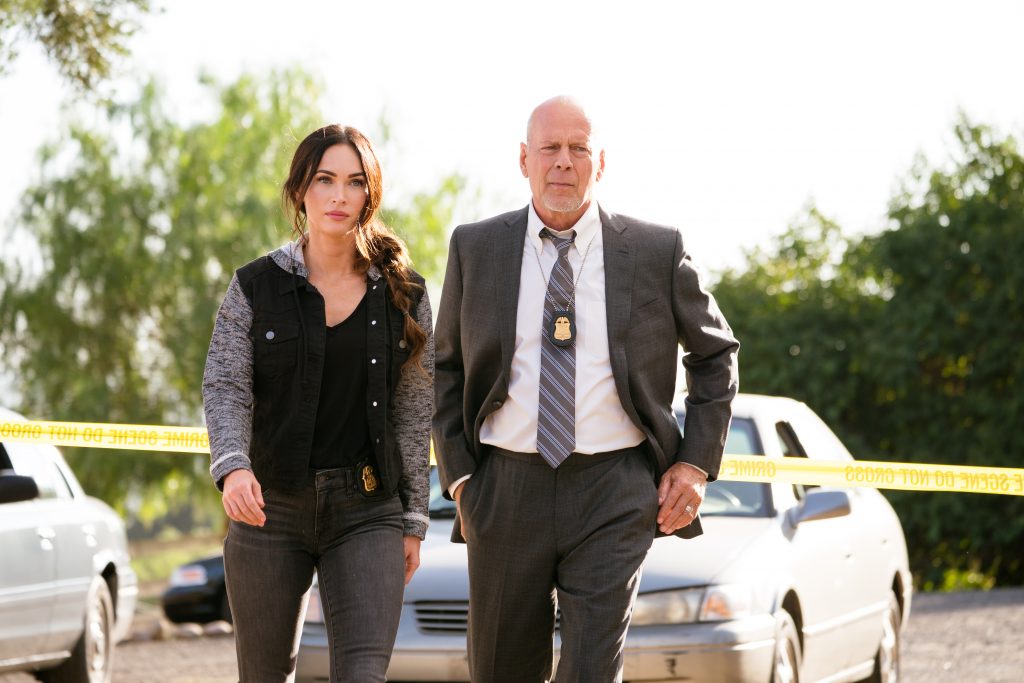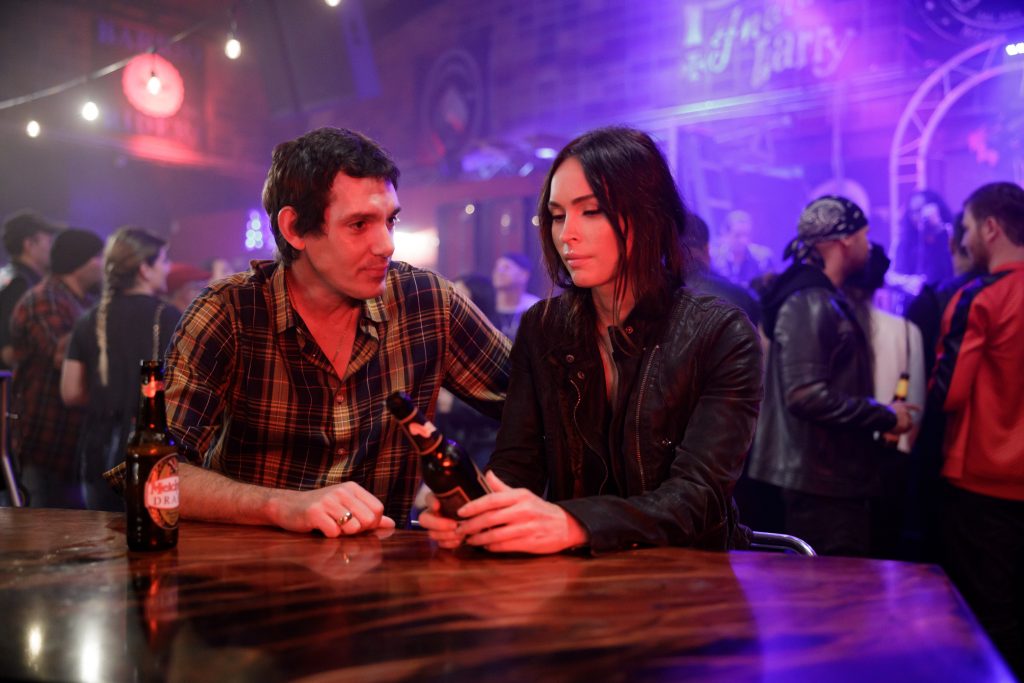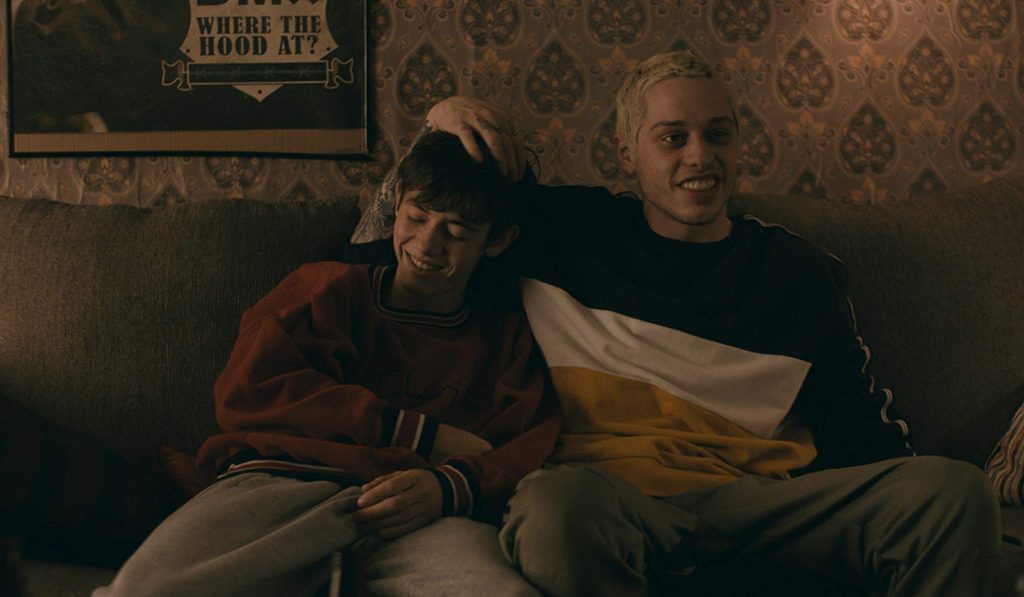February 4, 2022
by Carla Hay
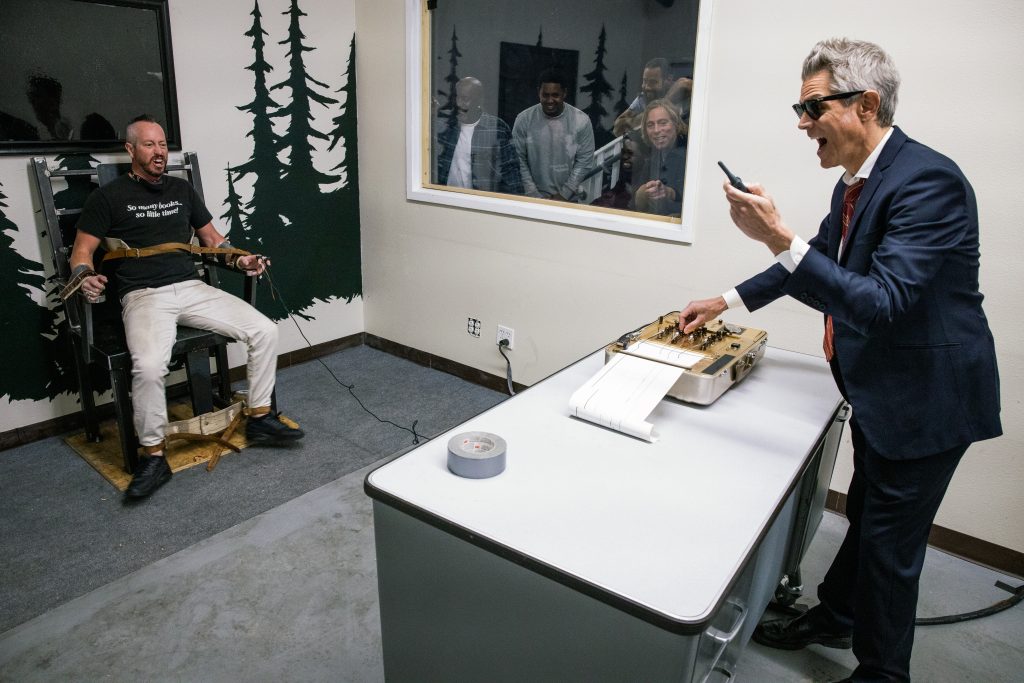
Directed by Jeff Tremaine
Culture Representation: Taking place in the Los Angeles area, the comedy film “Jackass Forever” features a cast of predominantly white people (with some African Americans) performing physically painful stunts, as well as playing pranks on each other and some unsuspecting people.
Culture Clash: This group of comedic pranksters push themselves to the limit in how far they will go to get laughs, even if some members of the group object to how dangerous these stunts can be.
Culture Audience: Besides appealing to the obvious target audience of fans of MTV’s “Jackass” TV series, “Jackass Forever” will appeal mainly to people who are interested in movies where adults engage in a lot of cringe-inducing antics.
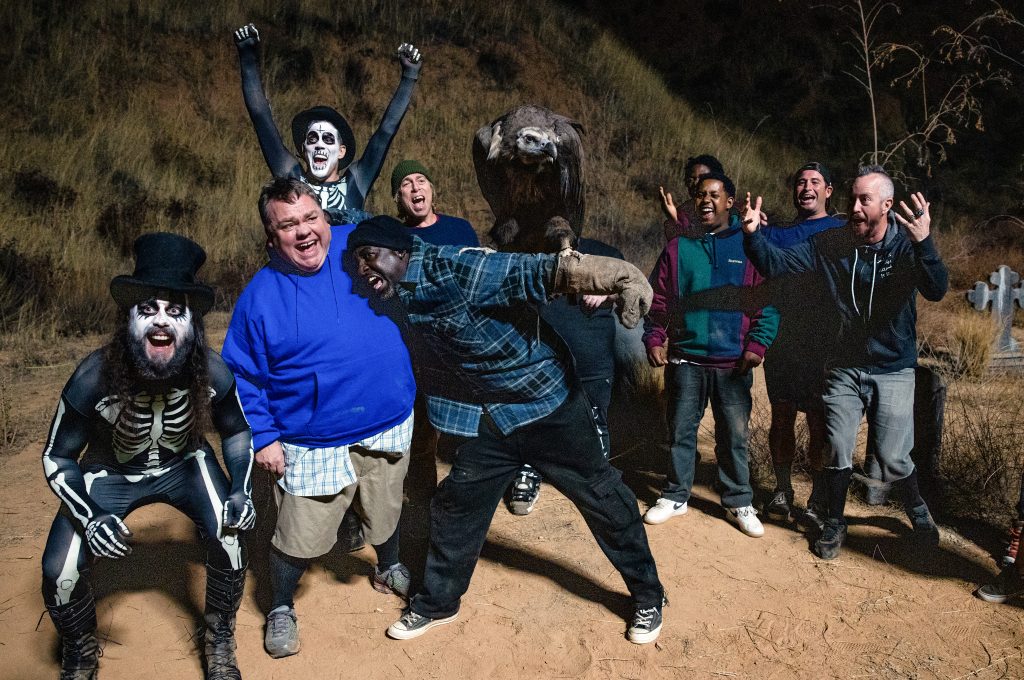
“Jackass Forever” delivers everything you’d expect it to deliver to “Jackass” fans: a compilation of gross-out comedy stunts and silly pranks. The movie doesn’t try to pretend to be anything else, although some parts of the movie are unnecessary filler. “Jackass Forever” reunites many of the original cast members of MTV’s “Jackass” reality TV series, which was on the air from 2000 to 2002, and spawned many spinoff series and movies.
“Jackass” was created by Johnny Knoxville (the franchise’s biggest star and on-screen ringleader), Jeff Tremaine and Spike Jonze. Knoxville, Tremaine and Jonze are producers of “Jackass Forever,” while Tremaine is the movie’s director. Jonze and Tremaine make brief on-camera appearances in “Jackass Forever.”
If you’re easily offended by movies that have numerous scenes talking about and showing naked male genitalia and bodily functions, then “Jackass Forever” should be avoided. However, people who can tolerate this type of comedy will find something to laugh at in “Jackass Forever.” Almost everyone seeing this movie will have some kind of awareness that anything with the “Jackass” franchise name on it will have crude and sometimes nauseating comedy. Pity any uptight person who sees this movie and is completely clueless beforehand on what to expect.
In “Jackass Forever,” Knoxville is joined by other members of the original “Jackass” cast: Steve-O (whose real name is Stephen Glover), Chris Pontius, Dave England, “Danger” Ehren McGhehey, Preston Lacy and Jason “Wee Man” Acuña. Original “Jackass” cast member Ryan Dunn died in a car accident in 2011, at the age of 34. (“Jackass Forever” flashes a brief tribute to him during the end credits.)
Bam Margera, another original “Jackass” cast member, was set to be in “Jackass Forever,” but he was reportedly fired after failing a drug test. (He tested positive for Adderall.) Margera has since had disputes with the “Jackass” team, and Tremaine filed a restraining order against Margera. “Jackass Forever” has some archival footage of “Jackass” where Margera can briefly be seen. Margera is not in any of the new footage that’s in “Jackass Forever.”
Also part of the “Jackass Forever” on-screen team are Sean “Poopies” McInerney (a self-described “Jackass” superfan) and Zach Holmes. The large sizes of Holmes and Lacy are used in a “Triple Wedgie” challenge with Wee Man, who happens to be a little person. Holmes, Lacy and Wee Man are wearing white mawashi-styled (sumo wrestler) loincloth in this wedgie challenge. It’s a scene in “Jackass Forever” that might offend some people who think body sizes are being exploited and ridiculed in this scene.
“Jackass Forever” has made some attempt to bring more diversity to the “Jackass” on-screen team. There’s a token female: Rachel Wolfson, the only woman who’s part of this prankster group. She actually has more stamina than many of the men in the group, who scream in terror at things that Wolfson can endure with silent aplomb. And there are some African Americans who are new to the “Jackass” franchise: Eric Manaka and Jasper (no last name) are both presented as part of the main group too. Jasper gets the most screen time out of all three of them.
“Jackass Forever” also has some celebrity cameos, with the unsuspecting celebs getting pranked. Musician/actor Machine Gun Kelly (also known as Colson Baker) gets sucker punched into a swimming pool in a stunt with Steve-O involving a stationary bicycle challenge and giant toy hands. Comedian/actor Eric André also gets blindsided: He’s hit with a giant tube-shaped balloon that bursts out of a beverage truck where André thinks he’s getting a free cup of coffee. Hip-hop music artist Tyler, the Creator is a pianist in a skit where he plays music while members of the “Jackass” team wear tuxedos and dance on a floor that gives electroshocks through the floor. Tyler, the Creator doesn’t escape these electroshocks either.
“Jackass Forever” has some stunts that are somewhat boring and over-used, compared to others. There’s a high-flying stunt with members of the group doing BMX riding on a “human ramp,” with the expected bike crashes and falls that ensue. Another stunt shows some members of the “Jackass” group dressed up as a marching band, and they walk on a treadmill, which predictably results in more tumbles and bruises. Knoxville catapults a soccer ball at Steve-O when he comes out of a production trailer on the movie set.
And there are explosions galore. Steve-O is using a porta potty when it explodes on him. In the movie’s opening sequence, another porta potty explodes on him, with feces (or something that looks like feces) flying everywhere and splattered all over Steve-O. In another scene, Knoxville, dressed as Icarus, explodes himself out of a cannon. Knoxville comments on this cannonball experience: “It feels like a 200-pound colonic up my ass!” And the movie ends with different types of explosions, involving vomiting on a Tilt-A-Whirl and being attacked by paintball gun attacks.
In one of the funniest scenes, England portrays a potential customer at a fake yard sale on someone’s front lawn. Unbeknownst to the people browsing at this yard sale, there’s a toilet “for sale” that’s been rigged to explode. First, England sits on the toilet as if to use it, while unsuspecting people look on in shock and disgust. No sooner does he sit on the toilet, then it explodes, as people react with horror. It’s a stunt that “Jackass” has done before. “Jackass Forever” features some other recycled stunts, with a select number of the original stunts shown in archival footage.
And speaking of doing “Candid Camera”-type of pranks on unsuspecting people outside of the group, “Jackass” has a few more. One of these pranks is when Knoxville reprises his disguised persona as an elderly grouch named Irv Zisman. As Irv, he goes into a furniture store with Wolfson (who plays Irv’s granddaughter), while Holmes pretends to be another customer. Holmes then falls from the second floor of the store and crashes into a piece of furniture that catapults Knoxville up like a cannon and causes Knoxville to crash through a ceiling.
Some of the most memorable stunts tap into the biggest fears that the “Jackass” team members have: damage to genitalia and being trapped somewhere with a wild animal that can cause bodily harm. Steve-O volunteers to have his naked genitals covered in bees. Lacy puts his genitals in a hole in a box and gets the genitals pummelled by mechanical fists.
Pontius encloses his penis in a ping-pong paddle device and “plays” with himself. (Use your imagination.) Wolfson says to him: “You’ll never be president [of the United States].” Poopies then jokes, “You never know. I’d vote for him.”
Danger Ehren endures the notorious Cup Test, where he wears a plastic cup guard over his genitals, but still voluntarily undergoes assaults to his groin area. His genitals are subjected to hard punches from mixed-martial-arts heavyweight Francis Ngannu; torpedo-like softball pitches from softball player Erin O’Toole; a hockey puck whacked by hockey player P.K. Subban; and pogo stick jumping from Poopies.
Animals that can kill humans are brought into the mix to bring on more terror. (In most cases, an animal trainer is nearby to prevent things from getting out of control.) Wolfson undergoes a “Scorpion Botox” challenge, where she has to let a scorpion bite her on the lip more than once. Poopies, England, Danger Ehren and Holmes are set up in “The Silence of the Lambs” challenge, where they are put in a dark room with a poisonous snake on the loose. In another stunt, Poopies loses a “mime” challenge and has to kiss a rattlesnake, which does exactly what you think it will do.
Jasper’s father—who goes by the nickname Dark Shark and is a self-described former gang banger—is recruited as a guest “Jackass” team participant. Dark Shark literally faces off against Danger Ehren in a challenge involving them wearing astronaut-sized glass helmets connected by a long tube. A large spider is then dropped into the tube, as Dark Shark and Danger Ehren frantically try to get the spider to go to the other person’s side of the tube and into the other person’s helmet. Later, Danger Ehren has the spider bite him on a nipple. Someone quips about the spider bite swelling the nipple: “Ehren went from a [bra size] AAA to a B.”
And there are two separate stunts involving “Jackass” guys being tied up and used as food bait for wild animals. The first of these stunts that’s shown in the movie is with a brown bear that is let loose in a room with Danger Ehren, who has honey and salmon poured all over his crotch. In the other stunt, Wee Man is tied up outdoors, with meat placed on him for a vulture to eat. Dark Shark is goaded into letting the vulture on his arm, and he shrieks that the vulture is biting him, when the vulture actually isn’t. Jasper than mutters on camera that he’s embarrassed by his father at that moment.
And it should come as no surprise that “Jackass Forever” uses semen (human and non-human) as part of the shenanigans. The movie’s opening sequence is a scripted scenario where members of the “Jackass” team are making a “monster on the loose” disaster movie, using miniature sets made to look like New York City. Pontius’ genitalia is used as a penis-sized dragon puppet running amok on the streets. You can guess that this dragon doesn’t spout fire but instead spouts something else on people. There’s another part of the movie where an unsuspecting England gets buckets of pig semen dumped on him. “I’m a vegetarian!” he says in disgust after finding out what was dumped on him, while everyone nearby laughs.
Even though “Jackass Forever” has a lot of high-risk stunts and pranks, a few of the stunts are tedious and weren’t worth putting in the movie. In one set-up, Knoxville instructs Wee Man to catch the much-larger and much-heavier Lacy and hold Lacy up in the air above his head, just like the famous dance move that Patrick Swayze and Jennifer Grey did near the end of “Dirty Dancing.” But this “Dirty Dancing” stunt never happened, because Lacy announces that he defecated on himself and pulls down his pants to prove it. (At least he gave enough advance warning, so viewers can look away.)
The anal fixation continues in a stunt where Steve-O is in a water tank, with the idea that he will fart underwater, and a methane-filled device nearby will cause an explosion. But apparently, the “Jackass” people don’t know basic chemistry about gas and water mixing, because this “experiment” doesn’t work until they bring in a methane blowtorch to force an explosion. It’s a stunt that’s ill-conceived and looks more like a clumsy outtake than something that deserved to be in the movie.
Don’t expect “Jackass” to show anything about the individual personal lives of these stunt/prank daredevils. Most of their personalities are indistinguishable from each other. Exceptions are obvious group leader Knoxville (who carries around a small taser that he uses to randomly zap people on the “Jackass” team) and Steve-O, who has long had the reputation of being the “craziest” of the “Jackass” team. Steve-O is the one most likely to laugh at himself and others during the most insane moments.
Out of everyone in the group, Danger Ehren gets the most methods of “torture” inflicted on him in “Jackass Forever,” by doing the most dangerous and nerve-wracking stunts that leave him bloodied and bruised. Knoxville does even more damage to himself, but from one stunt: While recreating a previous “Jackass” stunt where he tries to be like a bull matador in a pen with an angry bull, Knoxville (dressed as a magician) gets knocked out by a charging bull. He’s then shown being carried out on a stretcher, and then later getting out of a hospital. After being discharged from the hospital, Knoxville tells the camera that his bull-charging injuries were a broken wrist, a broken rib and a concussion.
As a disclaimer, “Jackass Forever” has warnings before and after the movie that all of the stunts were performed by professionals and shouldn’t be attempted by anyone else. It’s kind of a “covering our asses legally” façade though, because everyone knows that “Jackass” has inspired an entire industry of daredevil (mostly male) pranksters who want to be stars on social media for doing idiotic things that could cause bodily harm. As dopey and reckless as the “Jackass” franchise can be, if the purpose is to make people laugh, then “Jackass Forever” fulfills that purpose, although some people might laugh more than others.
Paramount Pictures released “Jackass Forever” in U.S. cinemas on February 4, 2022.

